EXCLUSIVE: Talking Stop-Motion and Story With The BoxTrolls Directors
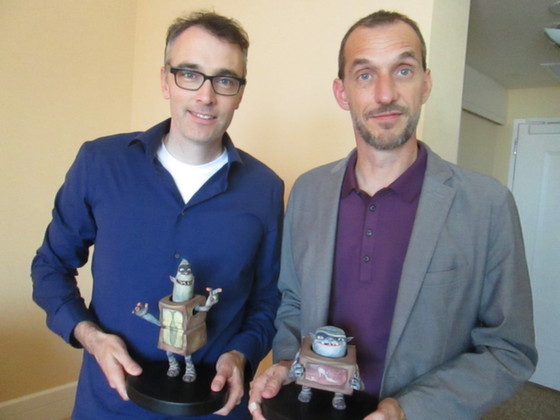 |
That’s Graham Annable on the left, and Anthony Stacchi on the right. Together, they’ve brought you The BoxTrolls, a slightly edgy stop-motion family film that keeps Laika animation three-for-three when it comes to quality (okay, Elle Fanning’s English accent is a little weak, but that’s it). Set on a strange, crooked mountain town where the elite merely wish to eat cheese all day, it focuses on the strange creatures who hide in boxes and underground and who have – as the film starts – been unjustly accused of kidnapping children (in fact, they’ve adopted one who needed their help). Their shy nature and unique language keeps them from speaking up for themselves, however and the prospect of capturing them gives some evil opportunists ideas about reward money and class mobility.
The directors were most enthused to speak to me about how they did it…
Luke Y. Thompson: So Anthony, you were one of three directors on Open Season. Now you’re one of two.
Anthony Stacchi: That’s right. We keep whittling it down.
LYT: What’s the difference, and are you going to go down to one on the next one?
AS: I don’t know. I’ve always liked having partners to do these things, and I think it helps to have – when you get into the heat of production, you can divide up to conquer the thing, and it makes it better overall. It was the first film that Sony did, and it was more the worried executives that got us into having three directors than anything that me and Jill [Culton] or Roger [Allers] wanted. We ended up all being able to work together pretty well, but three is one too many.
LYT: So two is a good partnership?
AS: Two is pretty good. Well, I think it is.
Graham Annable: Yeah, I think it worked out great.
LYT: For both of you, you’ve done so many types of animation. Is there a difference when you have the characters right in front of you, as tangible things?
AS: Yeah, there’s something inherently special about stop motion. I’ve worked as a 2-D hand-drawn animator, I’ve worked in CG, but nothing is quite like the actual puppets and actual sets. I worked as a storyboard artist on Coraline, and I still remember coming down to the stages for the first time, and seeing the set there, all lit with the puppets, and it’s just like, “Wow!” It’s just – I don’t know. There’s something really magical about it.
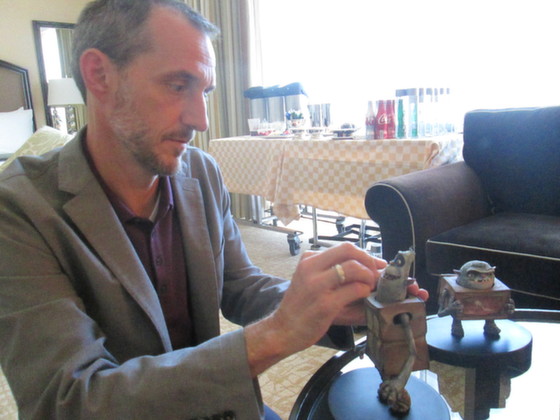 |
LYT: It’s interesting also – the marketing for this movie, at least initially, is focused on the technique, rather than the story.
[both]: Mm-hmm.LYT: Do you feel like maybe the story is in danger of being overshadowed a bit?
AS: We worried – I worried a little bit at first. I said, “No! Let’s show them how the characters are built before they get to see what the story is.” But the response to that was so great. Where people recall, “I remember that film now. I remember stop motion. I know it’s different from CG.” In a way, I think it helped us to get into people’s minds a lot more than just another trailer and story line. We knew we’d have two more story oriented ones after that one, too.
LYT: Was the response also positive to the first one that said there are all these different kinds of families? It seemed like maybe it was wading into political waters at the time a little bit.
AS: I think the response was great. It was actually a little bigger than we thought it would be.
GA: Yeah, it was a little surprising. We didn’t actually anticipate that kind of – as big a reaction as it seemed to garner. We just knew from all the different trailer ideas that had been proposed for that first one, that one fit the theme of our movie so well. Our movie was about family, and about the fact that this boy was raised by these weird, eclectic, strange BoxTrolls, and that families come in all shapes and sizes.
AS: Mm-hmm. And you can’t shy away from all the shapes and sizes that we know families have. I mean, besides the fact that that’s kind of what most of the people at Laika believe in, it was also a natural thing. When we started to write the text of what would be said over it, we gravitated to that place. So it would have been a job of censoring ourselves to remove that. We didn’t put it in there to – we knew it might be controversial, but we didn’t put it in there just to be that way. That’s where the text wanted to go.
LYT: I’ll tell you one thing I appreciate, and I breathed a huge sigh of relief on: I remember seeing the trailers and thinking, “This looks really cool, but I’m terrified that when I see it, it’s going to be a typical animated cutesy story line.” I loved that it retains that edge and it isn’t that.
AS: That’s great.
GA: Yeah, I’m glad to hear that, because yeah – that’s a big part of what we hope to achieve with the films that we make at Laika. We don’t ever want to sort of shy away from going to the darker places, and also then contrasting that with the happy, light places. We wanted to find – every film we make, we want it to have a really dynamic movie going experience. And I feel like in this day and age, a lot of the bigger studios, the bigger animated features, do tend to sort of shy away from that. They kind of stay in the middle of the road.
AS: Because they’re required to make so much money, because they cost so much, and their niche is a corporate one.
GA: Yeah!
AS: We’re an independent film producer, really. We happen to make animated films, and that’s super rare, that you get an independent animated film maker. We don’t have huge budgets, we don’t have to appeal to absolutely everybody. We can risk maybe only getting a few less people, and that gives us the freedom to tell the kind of stories that we want to see, and our families want to see, and that we want to make up there in Portland.
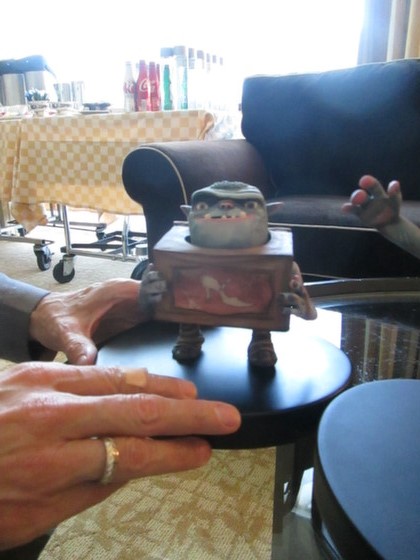 |
LYT: When you created these characters, who are sort of small and bizarre and have their own language, were you aware of the Minions from Despicable Me?
GA: [guffaws]
AS: We have been working on the movie for – Laika’s been working on it for 10 years. I’ve been on it for seven years. When that Minions movie came out in the midst of ours – when we already had our BoxTrolls all designed, I was worried that that’s what people were going to think.
GA: Yeah, yeah.
AS: We just hoped that they were different enough.
GA: Yeah, hopefully – that they are their own thing. We really worked hard to create unique creatures and a unique experience with these guys. But yeah – the Minions showed up half-way through our development on these guys.
AS: BoxTrolls were a big part, and probably the most unique creation in Alan Snow’s book, which is much older than 10 years old.
LYT: And you did obviously narrow it down. There were a lot more creatures in the book. How did that process come to be of focusing it on them rather than all the creatures?
AS: Trial and error. That’s why it took seven years!
GA: Yeah!
AS: There’s lots of drafts of the script that have Cabbage Heads, a couple that have Trotting Badgers and a few that have even the Sea Cows in it, and some others of Alan’s creatures. It just took a lot of ruthless economy. Once you got that core story about the little boy – the little orphan boy being raised by BoxTrolls and finding his place in the world, you could try to keep as much as you loved in the book, but after a while, if it didn’t contribute to that story, and what that story was about, and the themes that you were exploring, then it had to go.
GA: Yeah.
AS: It took a while.
GA: It took a while to get there.
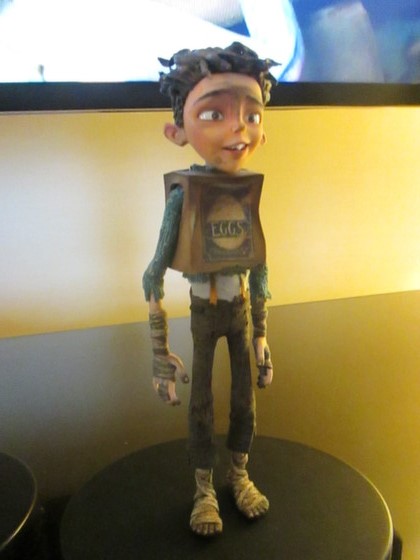 |
LYT: There’s a big kind of jump cut to when the boy grows up, and to some extent, I’m grateful that I don’t have to figure out how the BoxTrolls are going to do his diapers and teach him everything.
AS: We think that’s been covered by other movies.
LYT: Did you guys work it out in your head as to how that all would have happened?
AS: You know, we once had a version where you had two other versions of Eggs. He was about six years old, then he was about eight years old. Not only would that drive the producer nuts, because it would have required doing two more puppets – we tried to get away with just making his head size change, but that didn’t work at all.
It really – you need the story to get going then.
GA: Yeah.
AS: You really needed the story. He’s a baby, he’s been raised by – he has this intimate relationship – but then the next important thing that happened to him was when he went above ground. There didn’t really need to be any more intervening time in there. We did spend that time in there learning how he spoke English, or learning how he learned that red hats were bad, and then we just kept editing those montage growing sequences down and down and down, until we got just what we thought we needed.
GA: Yeah.
LYT: You talk a lot about trial and error. Did you have complete freedom about whatever time frame on this you want, or was there a release date at any point set in stone before you guys had finished?
GA: Through the pre-production, there isn’t a definitive “It needs to be all done at this point.” But the project sort of percolates and it hits a position and a time where it becomes clear that this is going to be the next film that we’re going to make at Laika.
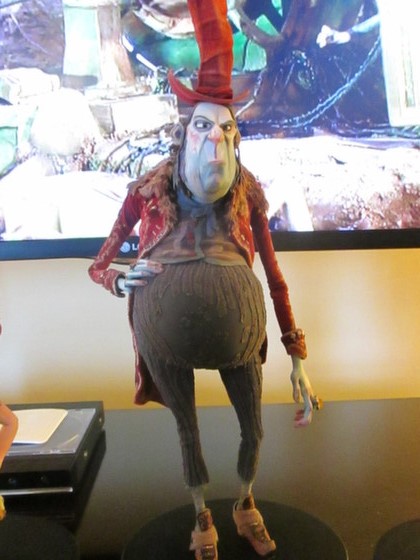 |
AS: Yeah.
GA: And then suddenly, the dates and deadlines begin to really show up.
AS: Yeah, when Travis [Knight, CEO] pulls the trigger and says, “The clock is starting now, we’re going to be released on this date,” not all the problems are fixed, by any means. But I think he feels it’s in a place where he can see the problems getting fixed, that they’re fixable. The story is within sight, and we’ll get there. There were still a lot of big story issues to get through when we started down the path of starting to build puppets, and we’re on track to finish the movie.
He at least has to feel confident. I always feel like the movie is ready to go. It’s perfect! And then waiting for Travis to get on board.
LYT: There are so many big names in the cast – at this point, how much is that you guys have to pursue the big names, and how much is it that they’ve seen a Laika movie and they really want to do a Laika movie?
AS: That’s a good question. It’s a little bit of both.
GA: Yeah, it really is. And I think we were fortunate – this being the third film out, that we had the other two films to reference, that people knew what Laika was about as a studio, and that made it a lot…
AS: Elle [Fanning] was a friend of the studio. Her sister had been in Coraline. So with her, we felt pretty confident that she knew who we were, and what we did, and she liked it. Isaac [Hempstead Wright] had seen the films before, so when we reached out to those guys, it was pretty good.
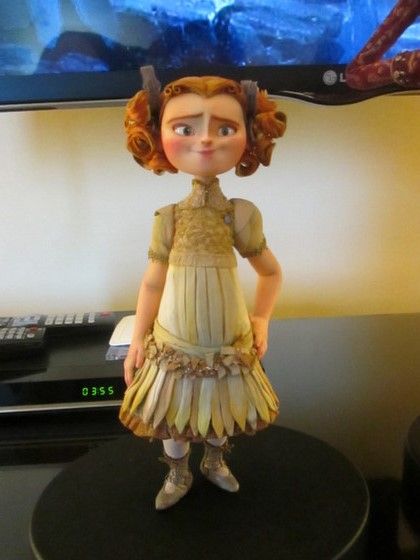 |
It was really gratifying, though, when Sir Ben [Kingsley] had seen what we’d done before, and clips of it, and he was interested in it. We figured a guy of his caliber had been asked and wasn’t interested in doing animation, because he had never done it before. So it was great when we asked him.
Nick Frost, Simon Pegg, and Richard Ayoade – they are the nerds you think they are!
GA: [laughs]
AS: So the idea of working in a stop motion movie really appealed to them.
GA: Yeah.
—
The BoxTrolls is in theaters now.
